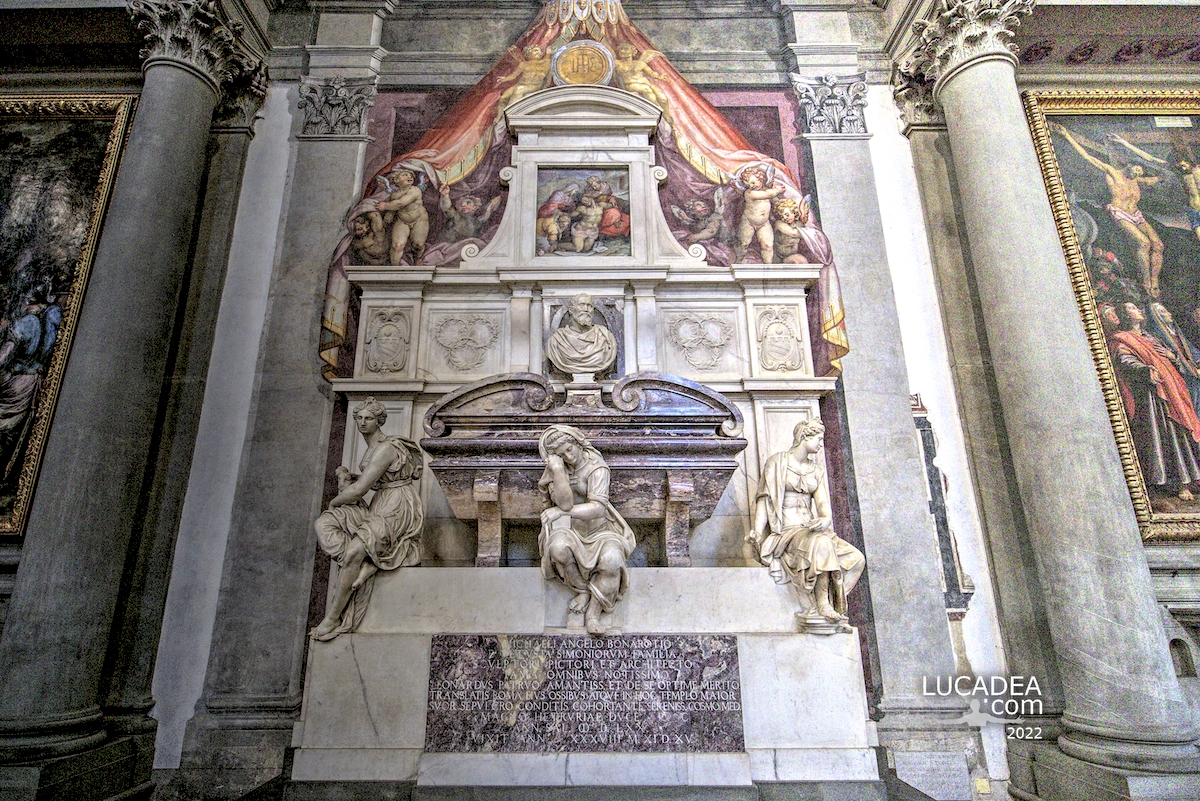Michelangelo's tomb in Santa Croce in Florence.
The city of Florence, rich in history and culture, holds within it a treasure of art and meaning: the tomb of Michelangelo Buonarroti located in the Basilica of Santa Croce. This sacred place, once the residence of illustrious figures such as Galileo Galilei and Niccolò Machiavelli, welcomes the great master of the Italian Renaissance with a solemnity and respect that are worthy of the greatness of his contribution to art and culture.
Michelangelo, born in 1475 and died in 1564, was one of the greatest artists in history. His influence extended through sculpture, painting and architecture, giving life to iconic works such as the statue of David and the Sistine Chapel. After his death, Florence dedicated a final resting place to him in the Basilica of Santa Croce, a place already consecrated for its many tombs of illustrious personalities.
Michelangelo's tomb was designed by Giorgio Vasari, another great artist and architect of the Italian Renaissance. The work, completed in 1578, combines architectural and sculptural elements in a fitting tribute to Michelangelo's greatness. The monument is located in the Buonarroti family chapel, located on the left side of the nave of the basilica.
Michelangelo's tomb is an eloquent example of Renaissance funerary art. At the center is an allegorical statue of Hope, flanked by statues representing Activity and Philosophy. The figure of Michelangelo, created by Vasari himself, is placed on a sarcophagus surmounted by a portrait of the deceased, executed by Daniele da Volterra. The whole is characterized by a sense of balance and harmony, typical of the Renaissance style.
Every element of Michelangelo's tomb is full of symbolism. Hope, with outstretched wings, suggests the immortality of art and the continuity of its influence over time. The lateral statues symbolize the duality of Michelangelo's life, between the creative fervor of the artist and the philosophical depth of his thought.
Michelangelo’s tomb in Santa Croce is a masterpiece that combines art and spirituality. Every detail, from the architectural design to the allegorical sculptures, tells the story of a man who shaped the aesthetics of the Renaissance. This sacred place is an essential stop for anyone who wants to immerse themselves in the artistic and cultural legacy of Florence, paying homage to one of the geniuses who made this city eternally legendary.
Do you know or have you visited this beautiful church in Florence? Add your own comment or go to the bottom of the site to read what other visitors have written.
Photo taken with Canon EOS M100 and lens Canon EF-M 11-22.
This is the official website: santacroceopera.it.
To see all the photos of the basilica click here:

The most famous tomb is perhaps that of Michelangelo Buonarroti, between the first and second altars of the right nave, designed by Vasari after the remains of the great artist arrived in Florence from Rome (1564). Above the tomb, three sculptures represent the personifications of Painting (by Battista Lorenzi, also author of the artist's bust) (around 1568), Sculpture (by Valerio Cioli) and Architecture (reattributed to Battista Lorenzi, previously attributed to Giovanni Bandini), saddened by the death of the great master, but the entire tomb is a mixture of painting, sculpture and architecture. The frescoes that decorate it are by Giovan Battista Naldini.
Continue and learn more on Wikipedia
Michelangelo’s tomb in the church of Santa Croce in Florence – Le tombeau de Michel-Ange dans l’église de Santa Croce à Florence – La tumba de Miguel Ángel en la iglesia de Santa Croce en Florencia – Túmulo de Michelangelo na igreja de Santa Croce em Florença – Michelangelos Grab in der Kirche Santa Croce in Florenz – Mộ của Michelangelo tại nhà thờ Santa Croce ở Florence – 佛罗伦萨圣十字教堂内的米开朗基罗墓 – フィレンツェのサンタ・クローチェ教会にあるミケランジェロの墓
The text of the post was written with the help of ChatGPT, a language model from OpenAI.
Add your own comment to this post or read here what other visitors have written.
I have taken many beautiful photos visiting monuments in Italy and around the world and you can see them in the various article dedicated to the topic.
Visit the Official Tourism Site and plan your next trip to Italy. Discover the wonders of the Italian territory: Italia.it.
Are you looking for a good book on the history of art? Then I suggest you look among the Bestsellers of Amazon to see what the public is interested in at the moment. If you want some guide to Italy from an artistic point of view, I invite you to see: Grand tour d'Italia a piccoli passi di Philippe Daverio e il classico Italia in 52 weekend. Itinerari inconsueti tra natura, arte e tradizioni by Lonely Planet. If you are curious about mysteries you could read I monumenti esoterici d'Italia by Fabrizio Falconi.
To learn more about our privacy and cookies policy, go to the bottom of the site.
This page has had 153 views total.

